Let’s cook one of my all-time favorite Vietnamese noodle soups: Bún Bò Huế. Bold, spicy, and full of aroma, this beef noodle soup hails from Huế—the former imperial capital and the soul of Central Vietnamese cuisine. If you ask most Vietnamese folks to choose between Bún Bò Huế and Phở, I’d bet at least 7 out of 10 would go for Bún Bò Huế—simply because of its rich, deep, and unforgettable flavors.
So here it is—my go-to recipe with a few local tips straight from a Vietnamese kitchen to help you make this iconic dish just right.
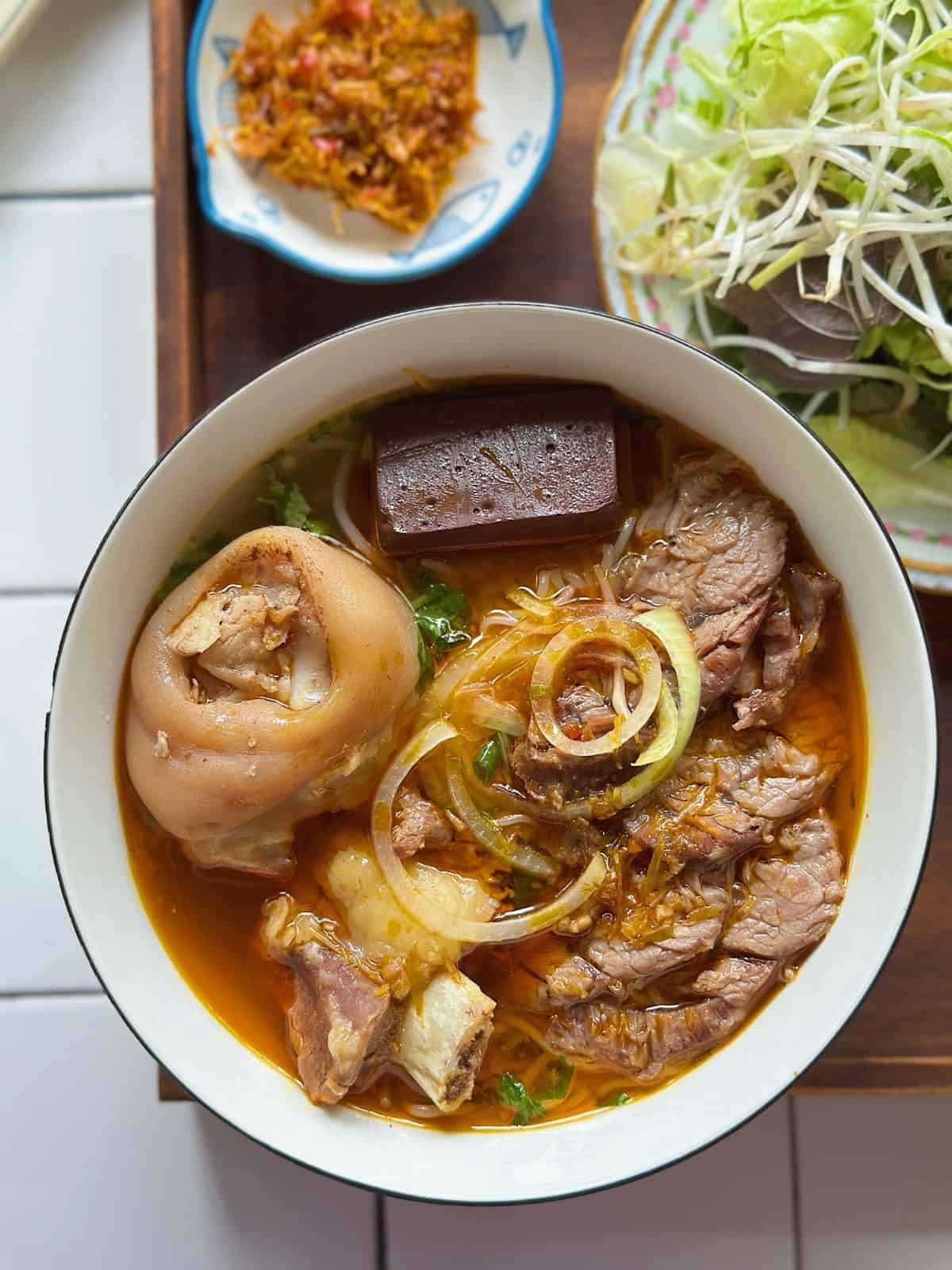
Bún Bò Huế – The Heart and Soul of Central Vietnamese Cuisine
Vietnamese cuisine is incredibly regional. Each part of the country brings its own iconic flavors to the table.
In the North, you’ve got classics like Phở and Bún Chả—light, balanced, and all about letting the ingredients shine.
Down South, it’s hearty and vibrant with dishes like Cơm Tấm (broken rice with grilled pork) and Hủ Tiếu Nam Vang, a noodle soup loaded with toppings and a rich, flavorful broth.
But when it comes to Central Vietnam, it’s all about Bún Bò Huế—a bold, spicy beef noodle soup that packs a punch. Then there’s Mì Quảng, with turmeric noodles, just a bit of broth, and a whole rainbow of toppings.

The name says it all: “Bún” are round rice noodles, and “Bò” means beef. Add “Giò Heo”—pork knuckle—and you’ve got the full version: Bún Bò Giò Heo.
Huế, where this dish comes from, is known not just for its imperial history but also for its amazing food scene. It’s where royal recipes meet everyday street food. Whether it’s a bowl of Bún Bò Huế, a sweet cup of Chè, or a unique Cà Phê Muối (salt coffee!), Huế brings something special to every bite.

What Makes a Real Bún Bò Huế
Honestly, making Bún Bò Huế isn’t as complicated as people think. It’s actually faster and easier than Phở—and the best part? You don’t need any fancy seasoning packets to get that authentic taste.
In Vietnam, we never use premixed stuff for things like Bún Bò Huế or Bún Riêu. What gives these soups their soul are real, fresh ingredients—lemongrass, shrimp paste, maybe some freshwater crab if you’re making Bún Riêu. And when you cook it the old-school way, the flavors just hit differently. Deeper, bolder, more alive.
For a proper Bún Bò Huế, there are two must-haves:

- Lemongrass. Lots of it. The more, the better. Fresh is ideal, but frozen stalks are totally fine too. Just skip the frozen pre-minced kind—it doesn’t have the same aroma or flavor.
- Mắm Ruốc Huế – this is a big one. Not just any shrimp paste will do. The one from Huế has a unique taste that’s essential for this dish. Don’t confuse it with Mắm Tôm from the North—they’re not the same at all.
Later, I’ll show you a simple tip I use to season the broth with shrimp paste—it adds just the right touch of funk without overpowering the lemongrass.
Now, about the noodles—there’s a bit of a debate. A lot of people think Bún Bò Huế has to be served with those thick, round noodles. And sure, they’re great for that chewy bite. But in Huế, locals often go for the thinner version. It’s really up to you: thick for texture, thin if you want the broth to soak in more.
And one last thing: pineapple. Some people add it to the broth, some don’t. I personally do, because it brings a natural sweetness. That way, I don’t need to add sugar. Just a small touch, but it really lifts the whole broth.
Ingredients
MAIN BROTH
- Beef – Go for stew-friendly cuts like beef shank or brisket. I’m using beef shank and a bit of beef ribs today—super flavorful and perfect for long simmering.
- Pork Knuckle – This one’s a classic in Bún Bò Huế. It adds a rich, savory depth to the broth. If you don’t eat pork, no worries—just use more beef ribs instead.
- Optional Toppings – If you want to take it up a notch, feel free to add huyết (blood pudding), giò sống (uncooked pork paste), or chả lụa (Vietnamese pork sausage). Totally up to you!
- Lemongrass, Shallots & Ginger – These are essential for both aroma and balancing out the strong beefy smell. Lemongrass especially gives the broth its signature fragrance.
- Onion & Pineapple – I love adding these to naturally sweeten the broth. No need for extra sugar.
- Mắm Ruốc Huế – This is key. It’s the fermented shrimp paste from Huế that gives the broth its funky, umami backbone. Don’t skip it if you want the real deal.
- Ớt Sa Tế (Vietnamese Lemongrass Chili Oil) – You can buy it ready-made, but I usually whip up a quick version with minced lemongrass, shallots, fresh or dried chili, and annatto oil (or just paprika powder if that’s what you have on hand).
- Salt & Fish Sauce – Season to your liking. I usually adjust at the end, once the broth’s fully developed its flavor.
OTHER INGREDIENTS
- Bún (Rice Noodles) – You’ve got options here. The thick round noodles labeled “Bún Bò Huế” are the classic choice, but regular thin round rice noodles work just as well. Both are totally authentic—it just depends on the texture you prefer.
- Veggies – In Saigon, people usually eat Bún Bò Huế with water spinach and banana blossom. In other central cities, you’ll often see it served with lettuce and mung bean sprouts. Overseas, I’ve seen Vietnamese use red cabbage too. Honestly, just use what you like and what’s available—it’s flexible.
- Herbs – For that fresh, herbal kick, I love adding Vietnamese coriander (rau răm), perilla leaves (tía tô), and Thai basil (húng quế). These herbs really bring the whole bowl to life.
Helpful Tips
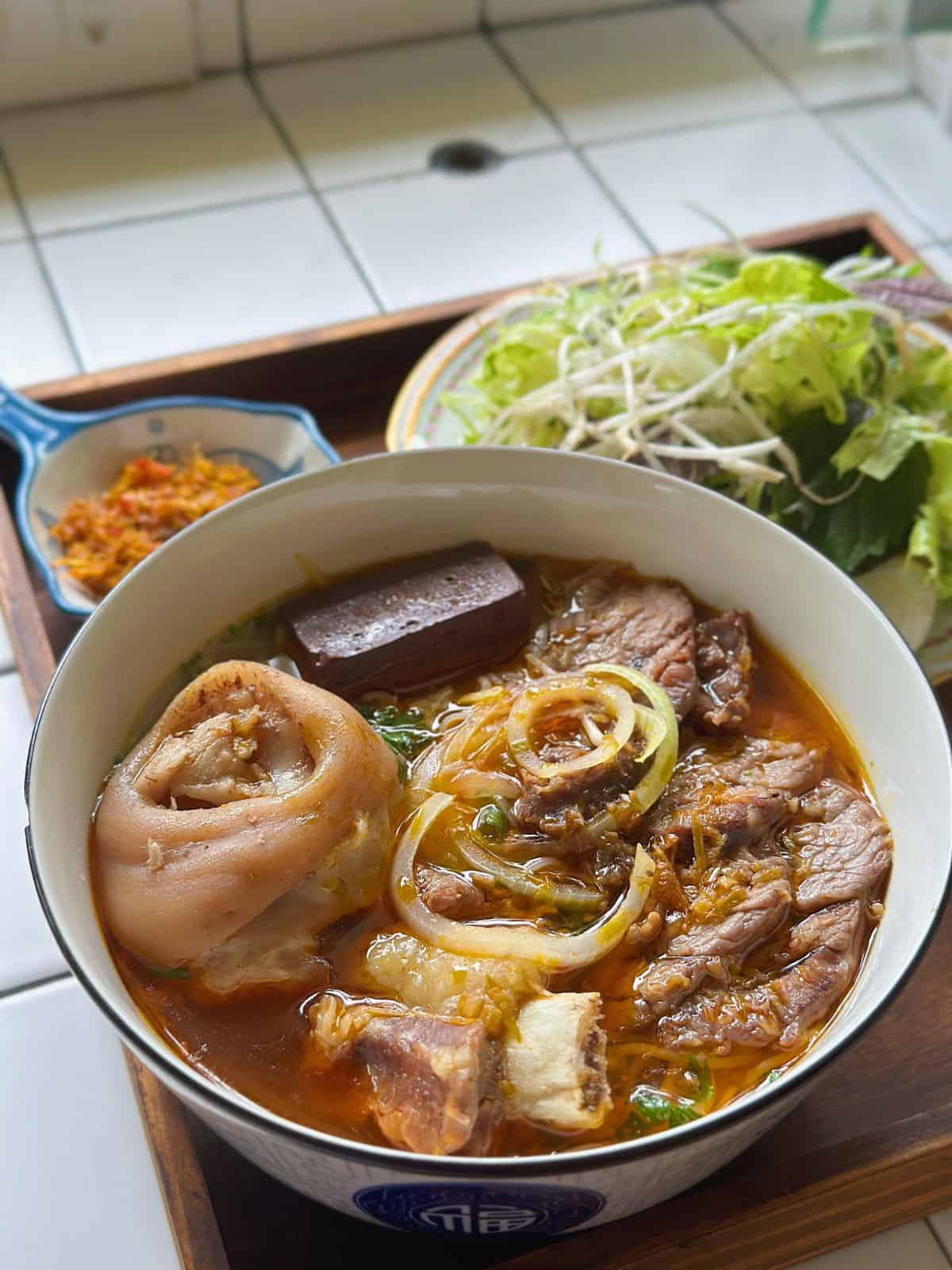
- Lemongrass and Mắm Ruốc Huế are the heart of this dish. Don’t hold back—more lemongrass means more aroma, and that signature shrimp paste from Huế adds the depth you need.
- Make your broth just a little saltier than you’d normally prefer—it’ll mellow out once you add noodles, herbs, and veggies.
- If you don’t have fresh pineapple on hand, rock sugar works great as a natural sweetener. Just don’t overdo it.
- When using shrimp paste, only use the clear liquid after it’s been dissolved in water. Never throw it in directly—it’ll overpower the broth.
- Thick or thin noodles? Totally up to you. Both are used in Vietnam, so go with what you like or what’s available.
- Even though shrimp paste plays a big role in the broth, Bún Bò Huế is traditionally served with fish sauce on the side, not more shrimp paste.
- And for my vegan friends—yes, Bún Bò Huế Chay exists, and it’s delicious. Give my plant-based version a try!
More tasty Vietnamese recipes

(Vietnamese Spring Rolls)
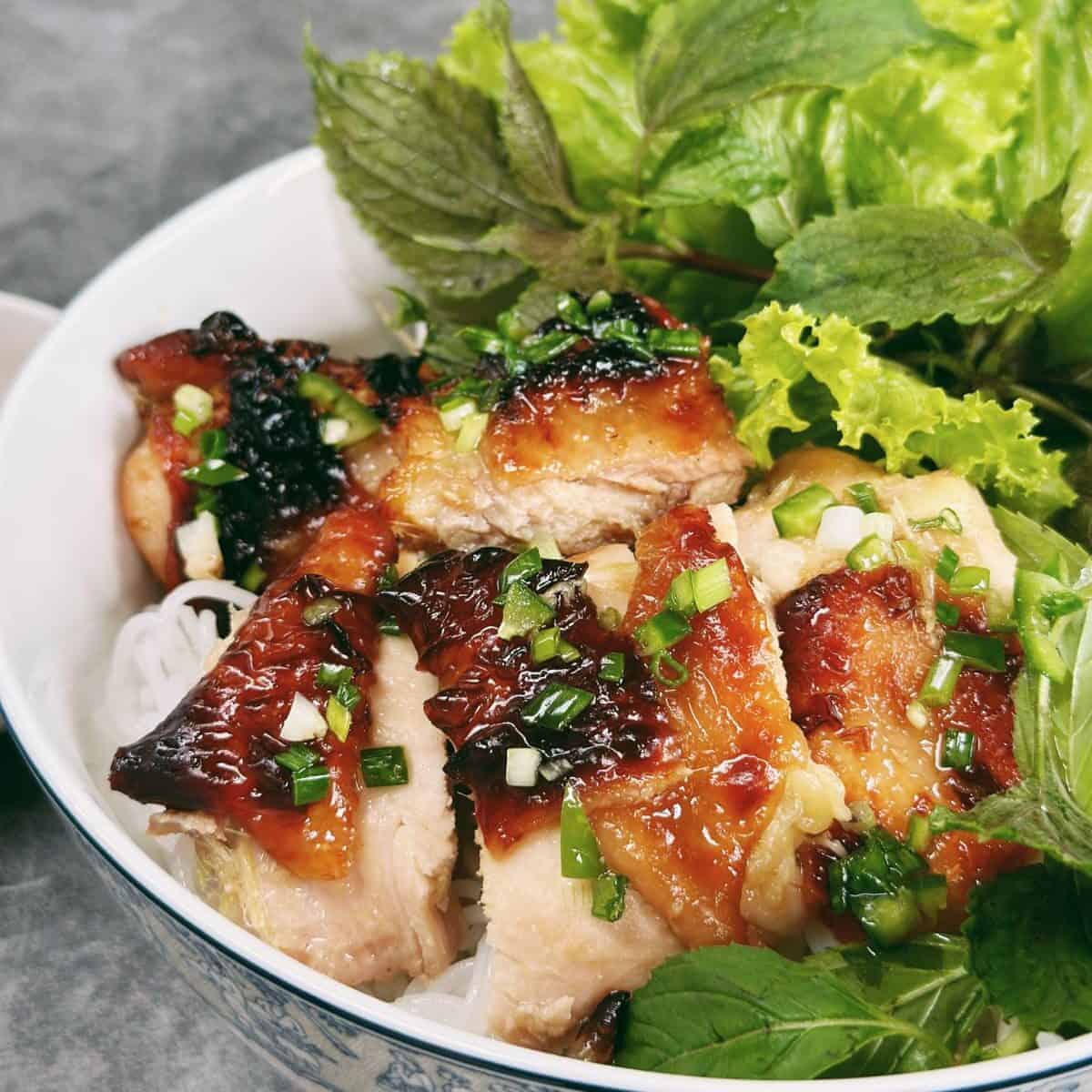
(Vietnamese rice noodle salad)
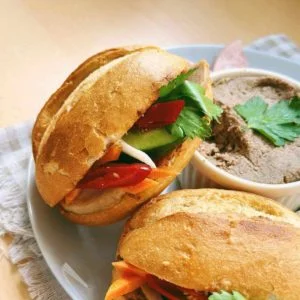
(Vietnamese Sandwich)

(Cà Phê Trứng)

Authentic Bún Bò Huế (Spicy Beef Noodle Soup from Huế)
Ingredients
Meat
- 2 pound beef shank (about 1 kg)
- 1 pound beef ribs (about ½ kg)
- 1 pork knuckle (about 1.7 pound/0.8 kg)
- Blood pudding (optional)
- 1 thumb-sized piece ginger (sliced) (for parboiling the meat)
- 1 tbsp salt (for parboiling the meat)
- 3 stalks lemongrass (bruised) (for the marinade)
- 3 shallots (sliced) (for the marinade)
- 1 tbsp Hue Shrimp Paste (mắm ruốc Huế) (for the marinade)
- 2 tbsp fish sauce (for the marinade)
Aromatics & Seasonings for the Broth (for 12.5 cups / approx. 3 liters of broth)
- 6 stalks lemongrass (bruised)
- 1 thumb-sized piece ginger (sliced)
- 1 bulb onion
- ¼ pineapple (peeled)
- 2 tbsp shrimp paste
- 1 cup water (240ml) (for dissolving the shrimp paste)
- 3 tbsp fish sauce (adjust to your taste)
- 1 tbsp chicken powder (adjust to your taste)
- ½ tbsp salt (adjust to your taste)
Sa Tế Sauce
- 1 tbsp minced shallot
- 3 tbsp minced lemongrass
- 2 tbsp cooking oil
- 2 tbsp annatto oil (or 1 tbsp paprika powder)
- 1 tbsp fish sauce
- ½ tbsp granulated sugar
Rice noodles, vegetables and herbs
- ½ bulb onion
- 1 pound Lettuce / water spinach / red cabbage / banana blossom (about 450g)
- ½ pound Mung bean sprouts (about 250g)
- Herbs (Vietnamese coriander, perilla leaves, and Thai basil)
- 1 package "Bún" rice noodles
Instructions
Marinate the meat
- Parboil the beef shank, beef ribs, and pork knuckle with salt and ginger slices. Rinse well under water.

- Marinate the meat with shrimp paste, fish sauce, shallots, and lemongrass for 30 minutes to 1 hour.

Prepare the broth
- Dissolve the shrimp paste in water, letting it sit for 1-2 hours until it separates into liquid on top and paste at the bottom. We will use only the liquid to season the broth.

- Heat cooking oil in a pot. Sauté the shallots and lemongrass from the marinade until fragrant. Add the beef and brown on all sides, then stir-fry the pork knuckles.

- Add water, onion, pineapple, ginger, and salt. Bring to a boil, then reduce heat and simmer for 40 minutes to 1 hour. Check the meat by pricking it with a chopstick—if it goes through easily, it’s done. The pork knuckle will cook faster than the beef shank. Remove the meat and let it cool. Discard the onion and pineapple. If you need more broth, you can add water, but don’t add too much—too much water will weaken the rich, savory flavor.

- In a small pan, heat oil and sauté minced shallots until fragrant. Add minced lemongrass and cook until fragrant, then stir in annatto oil, fish sauce, and sugar. Cook for one more minute.

- Add this lemongrass chili oil to the broth (or just the oil for a smoother broth). Pour in the liquid from the shrimp paste, discard the bottom layer, and simmer on low heat. Season the broth with salt and fish sauce to taste—it should be a bit saltier than usual.

- If you enjoy blood pudding (huyết), add it now and cook for 3 minutes. If using raw blood pudding, cook it separately first.
Serve
- Wash and rinse the vegetables and herbs, shred the veggies, finely chop the herbs, and thinly slice the onion.

- Cook the rice noodles as instructed on the package.
- Slice the beef shank into 1-inch (3cm) slices. In a bowl, add the noodles, beef, and pork knuckle. Sprinkle with herbs and onion, then pour the hot broth over.

- Serve Bún Bò Huế with fresh vegetables and enjoy!


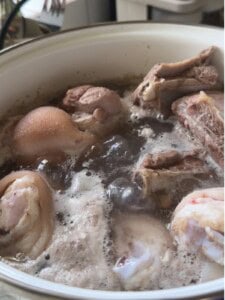
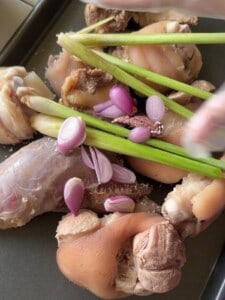
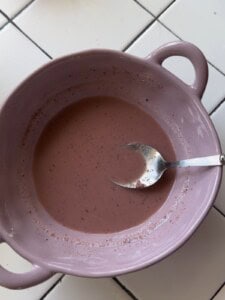
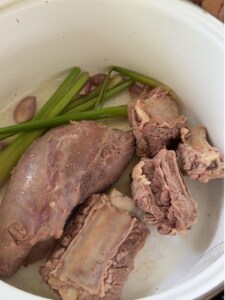
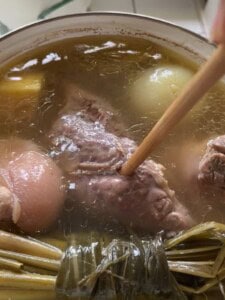
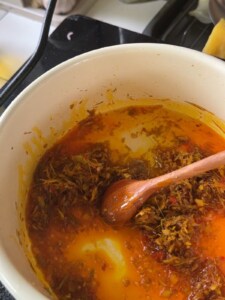
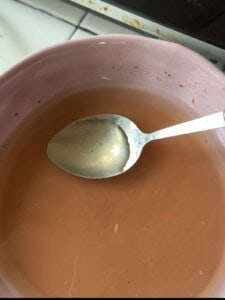
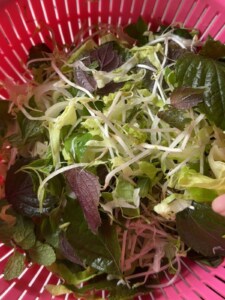
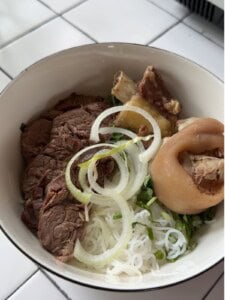
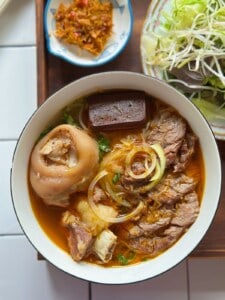
Thank you for this amazing recipe, I really appreciate that you always put so much effort into every post 🥰
I’m flattered. Your feedback really lightened up my day <3.